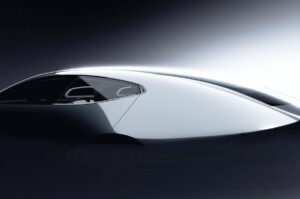Summary
- The Vision X-Coupé combines a two-rotor turbo rotary engine with electric motors for 503 bhp.
- Mazda aims for carbon-negative driving using biomass-derived fuels and tailpipe carbon-capture technology.
Mazda’s Vision X-Coupé concept pairs a two-rotor turbo rotary with electric motors to produce 503 bhp, about 99 miles of battery-only range and a quoted combined range of roughly 497–500 miles. Mazda says key technologies — including rotary drive, carbon-capture hardware and sustainable fuels — could reach production within the next few years.
What the Vision X-Coupé is
The Vision X-Coupé (revealed at the Japan Mobility Show) is a four-door sports saloon concept that evolves Mazda’s Kodo design language and revisits the rotary engine as a direct-drive element of a plug-in hybrid powertrain rather than only as a range-extender. Mazda quotes a total system output of 503 bhp and positions the concept as a showcase for sustainable rotary tech.
Powertrain and headline figures
- Architecture: Plug-in hybrid with a turbocharged two-rotor rotary + electric motor(s) + battery.
- Combined power: 503 bhp (≈375 kW).
- Battery-only range: ~99 miles (160 km) claimed (manufacturer figure).
- Combined range: Mazda quotes ~497–500 miles (≈800 km) when using the engine and battery together (CLTC/combined claim — see caveats below).
- 0–62/0–60: Mazda hasn’t quoted an official sprint time in every outlet; coverage focuses on packaging, range and emissions tech rather than a headline 0–62 figure. (Some outlets paraphrase performance expectations.)
Carbon-negative claim, fuels and carbon capture
Mazda says the Vision X-Coupé is intended to demonstrate a pathway to “carbon-negative” driving by combining:
- Carbon-neutral / biomass-derived fuels (Mazda refers to fuels from microalgae as a lower-energy, scalable route to synthetic fuel).
- A tailpipe carbon-capture device claimed to remove a further percentage of CO₂ from the exhaust stream.
Mazda’s CTO argues that, taken together, these measures could theoretically result in net negative CO₂ over the vehicle’s use phase — a bold claim that Mazda frames as complementary to battery-EVs rather than a replacement. These comments and the microalgae-fuel idea were emphasised during Mazda’s press materials and interviews.
Caveat: Mazda’s carbon-negative figure is a theoretical projection that depends on fuel sourcing, lifecycle accounting and the real-world effectiveness of the carbon-capture hardware. Independent verification and lifecycle analysis would be required before the claim can be treated as proven
Where this sits vs Mazda’s recent rotary work
- Mazda has previously used the rotary as a generator in the MX-30 R-EV; the Vision X-Coupé takes the next step by using a driving rotary again, a technical leap in emissions control and combustion stability across the rev range. Mazda says it has a dedicated Rotary Engine Development Group and expects further work over two to three years to refine emissions and durability
Practical range & testing notes
The battery-only 99-mile figure and ~497–500-mile combined claim come from Mazda’s test-cycle reporting (manufacturer media materials). Reporters note these are concept/press figures and will be subject to WLTP or regional test-cycle re-calibration if the tech moves towards production. Expect WLTP and real-world numbers to be lower than the concept’s lab claims.
Design, packaging and size
The Vision X-Coupé measures about 5,050 mm long with a rakish coupe-saloon silhouette — a size comparable to the Polestar 5 and Lotus Emeya — and reinterprets Mazda’s Kodo idiom with a long bonnet, a cab-rear profile and a premium GT character. Interior and exterior styling borrow cues from Mazda’s recent concepts (Iconic SP, RX-Vision) and point to a potential high-end grand-tourer direction.
Production prospects & timeline
Mazda indicates technologies and some design elements from the Vision X-Coupé could appear in production models; the company also suggests the next-generation rotary work could reach production or range-extender roles in the next 2–3 years. Mazda stops short of promising a factory-exact Vision X-Coupé production car but places the concept squarely in its near-term R&D roadmap.
Potential hurdles & questions
- Emissions control: a rotary used as a drivetrain faces higher inherent hydrocarbon and NOx emissions challenges; Mazda says further development is required to meet global emissions standards across all rev ranges.
- Carbon accounting: delivering a genuine carbon-negative outcome depends on fuel production (microalgae scale-up), capture efficiency and lifecycle sourcing — each a non-trivial challenge.
- Durability and service: rotary engines and carbon-capture systems introduce maintenance and durability questions that must be resolved for mainstream adoption.
Quick spec summary (concept claims)
| Item | Vision X-Coupé (Mazda claim) |
|---|---|
| System power | 503 bhp (≈375 kW). |
| Battery-only range | ~99 miles (160 km). |
| Combined range | ~497–500 miles (≈800 km) (manufacturer combined claim). |
| Engine | Turbocharged two-rotor rotary (driving the wheels). |
| Powertrain type | Plug-in hybrid (rotary + motor(s) + battery). |
| Length | ~5,050 mm (Mazda figure). |






GIPHY App Key not set. Please check settings